
Garibaldi class armoured cruisers (1901)
 Italy (1894-1904)
Italy (1894-1904)
10 Armoured Cruisers (+1 cancelled). Italy: Giuseppe Garibaldi, Francesco Ferruccio, Varese
The best Italian Armoured Cruisers ?
Among the best armoured cruisers of their time with 10 ships built (11 planned, one cancelled), The Garibaldi class were sold to Argentina, Spain and Japan. Italy operated Varese (launched 1899), Guiseppe Garibaldi (1899) and Francesco Ferruccio (1901). They were designed by chief engineer Edoardo Masdea in 1893, combining elements that would make their success, a perfect balance of armament, protection and speed given their limited specified tonnage, and the ability to join a battle line. The class is either referring to the Argentinian “Garibaldi” or the Italian one, a rare case in ships classification, but based on the same historical figure. Despite a design dating back 1893, the last were launched in 1904 for Japan, a mere year before the construction of HMS Dreadnought. They all saw plenty of service on all oceans, with two lost in action.
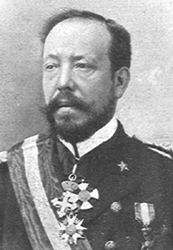 About Edoardo Masdea: Born in Naples, 23 July 1849 died in Rome, 12 May 1910, a naval engineer, politician and general.
About Edoardo Masdea: Born in Naples, 23 July 1849 died in Rome, 12 May 1910, a naval engineer, politician and general.As a general grade naval engineer, Masdea designed various naval classes of the Regia Marina at the end of the nineteenth century, including the armored cruisers of the Vettor Pisani class. At a suggestion of Benedetto Brin, he also worked on the Giuseppe Garibaldi class, meeting with considerable success in terms of sales abroad. He worked later on the Pisa and San Giorgio classes, as well as the first monocaliber battleship (or dreadnought from the name of the first ship of this type built) of the Regia Marina: Dante Alighieri.
He was awarded the Commander of the Order of Saints Maurice and Lazarus, Commander of the Order of the Crown of Italy ribbon, Gold Cross for Long Service (40 Years) and Commander of the Order of the Legion of Honor in France.
The Garibaldi class were in short, very versatile ships able to hold their place within the fleets line, ands perfect intermediaries between heavy cruisers and battleships. In addition, they were built quickly (4 years against often 6 to 9 for French ships) and at a lower cost than other most European shipyards making them an attractive proposition on export. Thus, they became the first major export success of Italian military shipbuilding at the time, for many years, and in fact the largest cruiser export for a European player outside Britain (Armstrong anyone ?). Indeed a total of 10 units were built, of which 3 for the Regia Marina and 7 for foreign navies.
Design Genesis
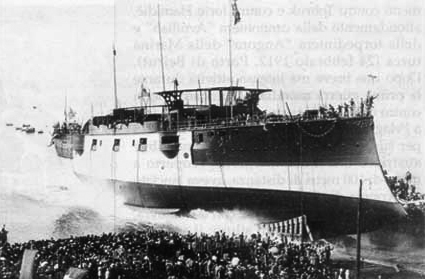 The design of the Giuseppe Garibaldi-class cruisers was submitted to naval architect Edoardo Masdea known for his successful, earlier Vettor Pisani-class. He was submitted an admiralty project that was reworked by him as chief naval engineer, conducting studies following directives of the Minister of the Navy Benedetto Brin, crossed with suggestions by Ansaldo Yard commissioned to build the first ship. Brin suggested to rework the design indeed of the Vettor Pisani class in the light of new characteristics presented by St Bon class Battleships. It would have been odd to have battleships faster than cruisers…
The design of the Giuseppe Garibaldi-class cruisers was submitted to naval architect Edoardo Masdea known for his successful, earlier Vettor Pisani-class. He was submitted an admiralty project that was reworked by him as chief naval engineer, conducting studies following directives of the Minister of the Navy Benedetto Brin, crossed with suggestions by Ansaldo Yard commissioned to build the first ship. Brin suggested to rework the design indeed of the Vettor Pisani class in the light of new characteristics presented by St Bon class Battleships. It would have been odd to have battleships faster than cruisers…
The basic concepts behind the project were:
-Cruisers able to work as “normal” armored cruisers (commerce raiding notably) and line units, operating closely with the fleet.
-Facing enemy formations of protected cruisers, even in individual missions, and thus having heavy armament and protection.
-Being still able to out-run battleships due to a higher speed.
In the end, Brin was confirmed in the idea that Vettor Pisani was a good starting base by Masdea, but he revised it to gain an increase in displacement, no less than 1000 tons to reach the difficult requirements, in large part the larger hull meant to accomodate a greater powerplant. The first design was deemed satisfactory on this base as everythibng match the upgraded design: Better armament, still adequate protection 20 knots as a top speed. The classic “impossible trilogy”, nightmare of all naval engineers, between armament, protection and speed for once was perfectly well balanced. The displacement also reflected this fact, with 40% of the total going to structural weight, 15% to artillery (including ammunition), 25% to the armor, 20% to the powerplant.
This new design was slightly larger, a knot faster than the Pisanis, with the improvement of two twin gun turrets fore and aft of the superstructure, which remedied the primary armament on the broadside for older ships, not able to engage targets forward and aft.
Design of the class
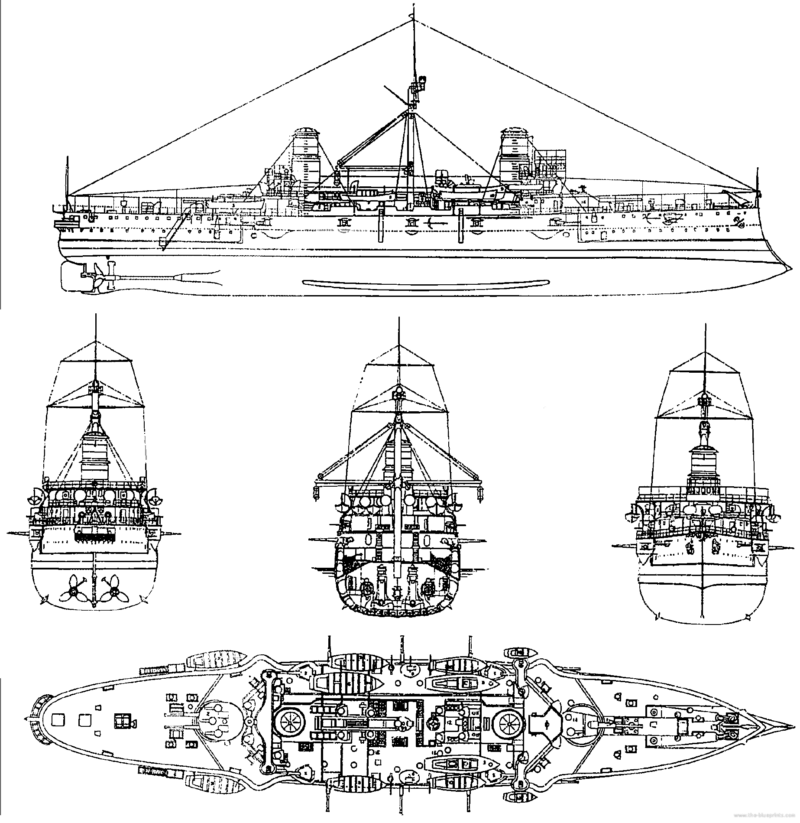
Hull and general design
The hull was continuous (flush deck) with a rounded (pointed fom above) stern, high freeboard. Their width/length ratio favored stability more than speed, making them good platforms, and agile in navigation. Superstructures were almost completely symmetrical, with a reinforced bow ram. In the central section, between the two brirges there were located the two well apart funnels, both with a circular section.
In between was located a single military mast, with a spotting and fighting top. It supported at its base two boom cranes for the numerous service boats, pinnaces and cutters aboard. The steam pinnaces were unarmed but will be put to good use during landing parties. The rudder was of the semi-compensated type. The general architecture saw superstructures reduced to the essential minimum, offering a smaller target, tonnage and aor drag as well. Though, the bridge had an enclosed level with broad wings and open deck above. This design remaind the same for all vessels of the class. Only the armament changed.
Armour protection layout
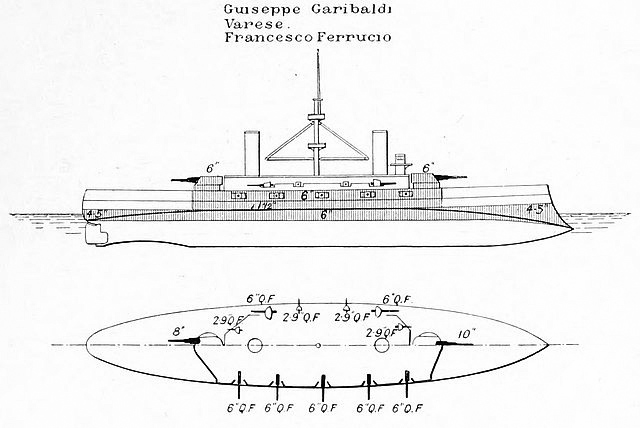
The ship’s armor was made of Harvey-type case-hardened steel. It was cast locally at Terni in Nothern Italy, using a process treating surfaces of nickel steel with carbon for high hardness. So the structural strenght was provided by internal iron bracing. Krupp managed later to obtain more elastic ensemble with adding chromium in the steel alloy.
On the Garibaldis it was nickel-plated steel reaching 150 mm for the main belt, tapered down to 80 mm at both ends.
-The central citadel had 130 mm thick transverse bulkheads.
-The armored deck reched 38 mm on the slopes.
-The turrets and barbetes reached 150 mm
-The 152/40 casemates were protected by 130 mm shield.
-Underwater protection consisted of a double bottom but only a few compartments above to protect the machinery space. This was unsufficient as shown by the loss of Garibaldi by a single torpedo hit in WWI.
To resume: belt 75 to 150mm, upper belt 150mm, main barbettes 100 below deck, 150mm above, main turrets 150mm, casemates 150mm, armor deck 25 (flat section) to 38 mm slopes. Conning Tower 150mm.
Powerplant
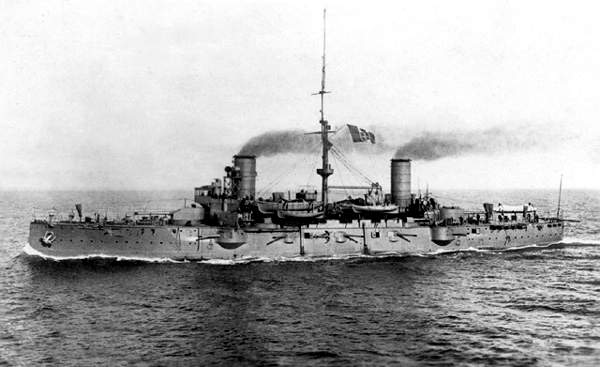
Garibaldi in 1915
The Garibaldi class cruiser’s powerplant consisted of two triple expansion, reciprocating steam engines. They were in turn fed by the high pressure steam coming out from 24 boilers, coal-fired with a reserve of 1,200 tons. Ansaldo, Hawthorn, Guppy, Orlando, Belleville and Niclausse provided the VTE and/or boilers including the export cruisers. These VTE engines drove in turn two shafts, and their two bronze propellers.
Trials had Garibaldi reaching 14,713 hp (13,655 not forced heated), for a speed of 19.7 knots. Close results were provided by her sister’s tests: Varese reached 14,713 shp and Ferruccio 13,500 shp. Varese had 24 Belleville boilers, Giuseppe Garibaldi and Franceso Ferruccio, 24 Niclausse boilers. The “standard” was 19.5. Varese reached 20 on trials, the faster of them all, and Ferruccio: 19.3.
In normal use, although design rated at 20 knots (37,04 km/h), they rarely reached more than 18 knots. Autonomy, or radius of action was either 9,300 nautical miles or 4,400 at 10 knots. Most sources states it was 5,500 nmi (10,200 km; 6,300 mi) at 10 knots. It could be caused by their “normal” and “wartime” coal load, with all empty compartments filled. This speed was not stellar: The follow-up Pisa class indeed cranked up 23 knots based on 10,000 tonnes, but almost half the range at 12 knots with 2,500 nmi (4,600 km; 2,900 mi).
Armament
The overall class was unusual in that it was not an uniform armament. Earlier group (4 Argentinian and Colon) had single 10-inch (254 mm) Elswick Pattern R guns in their turrets fore and aft. The next group, Italian and and Japanese ships, had a mixed armament: Single 10-inch (254 mm) forward, twin 8-inch (203 mm) aft. Nisshin had four 8-inch (203 mm) in twin turrets. Cristobal Colon had its own 10-inch defective, removed, and thus came to Cuba with just her ten Armstrong casemated 6-inch guns. The Italian 10-in proved formidable “fort levellers” during their careers, but worn out rapidly.
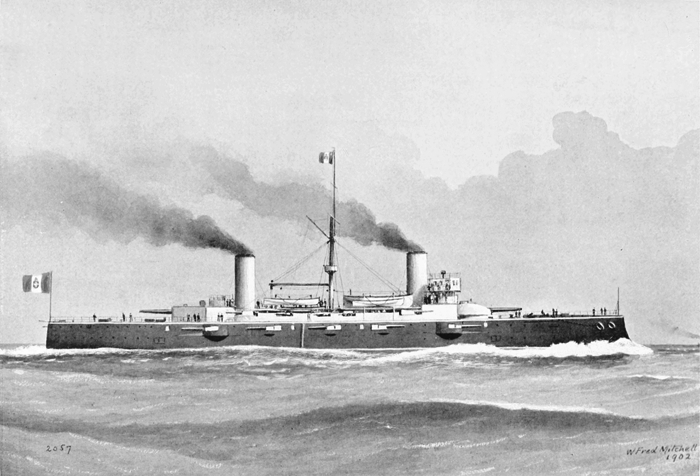
Giuseppe Garibaldi, Brasseys Naval Annual 1902
Main
The main armament of the Italian cruisers was mixed:
-One EOC 10 gun Armstrong Pattern R 254mm/40 (10 inches) in the forward turret. 30,5 tons, Elevation 35°, range 19,700 yards (18,000 m), ROF 1.5 rpm 1
Note that Francesco Ferruccio had a 254mm/40 A99 forward, unlike the 254/40 A Type of the others;
-Two EOC 8, same Pattern W 203mm/45 (8 inches) in aft twin turret. 19 tons, Elevation 25°, range 19,700 yards (18,000 m), ROF 2 rpm 2
These cannons were build under licence by Società degli Alti Furnaces, Foundries and Steelworks, of Terni, which also procured the armor plating.
Secondary
Fourteen single 152mm/40 (6 in) A99 pattern (Ansaldo Terni cannoni da 152/40). All three carried the same casemated guns, located in five side positions amidships: The four outer ones were encased in armoured sponsons to fire in chase and retreat. The other three either side were only capable of a limited traverse, broadside fire. They fired a 256 lbs. (116 kg) shell, with a bagged charge;
Performances: mv 2,592 fps (790 mps); 19,700 yards (18,000 m); 2 rpm 3
Tertiary
All three shared the exact same tertiary armament.
Ten single 76mm/40 A Pattern (3 in) guns: 1894+ QF 12-pounder 12 cwt naval gun, licenced later by Ansaldo as the Cannone da 76/40 Modello 1916. 15 rpm, mv 2,210 ft/s range 11,750 yd (10,740 m) 40°
Six single 47mm/40 H Pattern (1.9 in) guns: Hotchkiss 3-pdr, 30 rpm mv 571 m/s (1,870 ft/s) range 5.9 km (3.7 mi) at +20°
The 76 mm were located on the bridges and in embrasures on the hull, at the prow and stern. The 47mm were located also on the bridges, inclusing on extended wings, and upper gallery above the battery deck.
Two 6.5mm/115 Maxim Machine guns, when commissioned, likely Fiat–Revelli Modello 1914 from 1915. They were deployed on the steam cutters for landing parties and support.
Torpedo Tubes
Four single broadside 450 mm (17.7 in) torpedo tubes. Whitehead Type 1890, from Fiume.
Design Differences
For ships built between 1892 to 1903, design improvements and changes in armaments and sub-systems occurred. The the three ships actually accepted by Italy were true sisters, with totally similar caracristics. All were built by Gio. Ansaldo & C. in Genoa-Sestri Ponente, but ARA San Martin and ARA Belgrano in Orlando, Livorno. The first five, the Argentinian ones and Spanish Colon, were built to the same dimensions displacement, however the Garibaldi “sub-class” and last Kasuga and Nisshin were stretched by six frames amidships. The first group tuhus measured 106.94 meters (350 ft 10 in), for 18.2 meters (59 ft 9 in) in beam and deep draft of 7.1 meters (23 ft 4 in). Displacement was 6,840 metric tons (6,730 long tons) at normal load, although General Belgrano is reported by to have had a beam of 18.8 meters (61 ft 8 in) -Not in Conways- and thus displacing some 300–400 metric tons more.
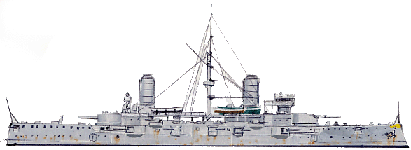
Illustration of the Garibaldi in 1914
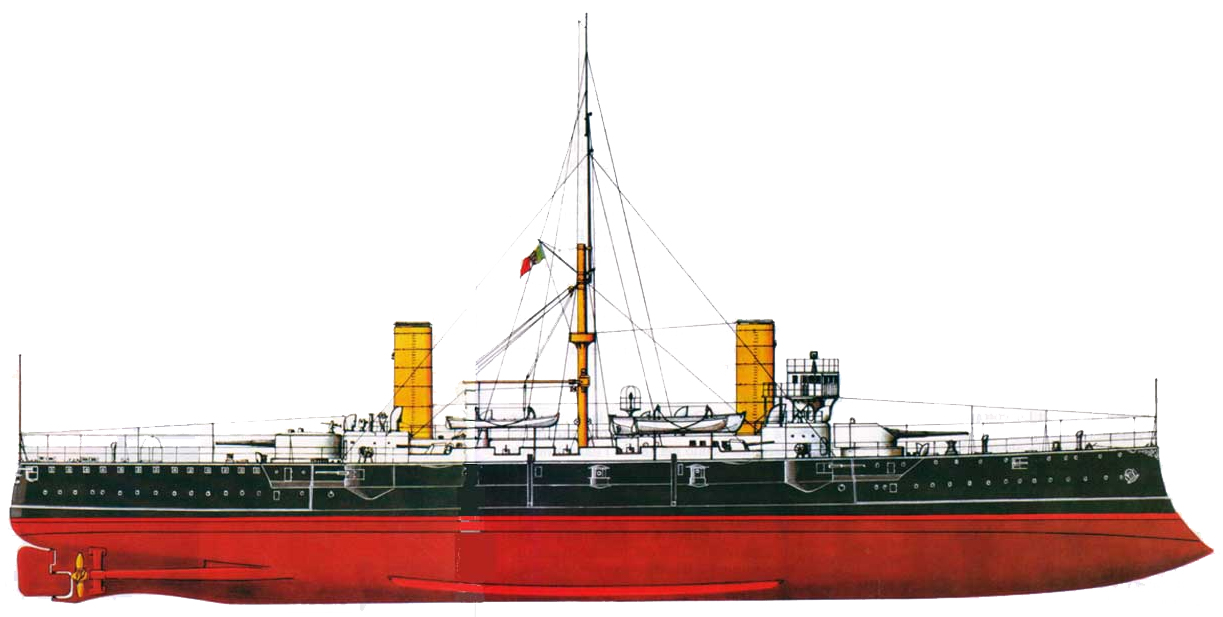
HD Profile of G. Garibaldi as completed in 1901 src
⚙ specifications |
|
| Displacement | 6,840 t standard 7,400–7,700 t FL |
| Dimensions | 108.8/111.73 oa x 18.9 x 7.32 m (366 ft 7 in x 62 x 24 ft) |
| Propulsion | 2 shafts VTE, 8–24 Boilers 13,000–13,500 ihp (10,100 kW) |
| Speed | 20 knots (37 km/h; 23 mph) |
| Range | 5,500 nmi (10,200 km; 6,300 mi) at 10 knots (19 km/h; 12 mph) |
| Armament | 1x 254, 10x 152, 6x 120mm, 6x 76 mm, 4x 47mm, 4x 450 mm TTs. |
| Armor | Belt 70-150, CT 150, turrets 190, decks 100-150, barbettes 10-150 mm |
| Crew | 555 total, 578 as flagship |
Exports & Final Assessment
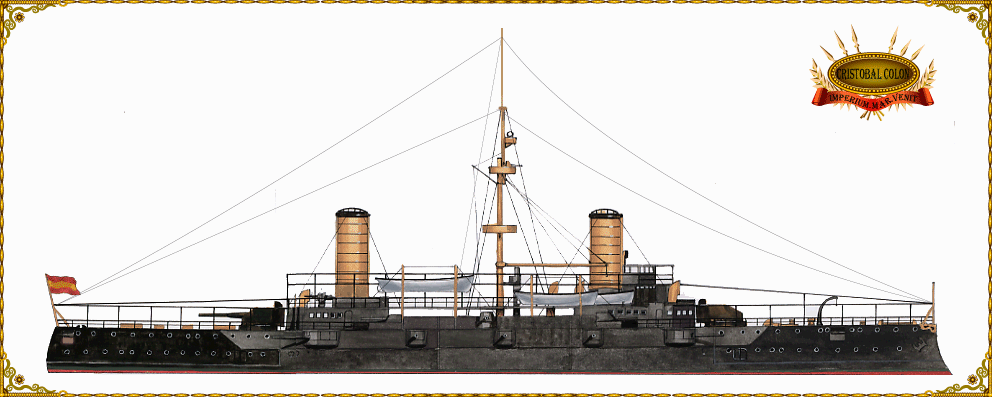
Cristobal Colon, showing her complete lack of heavy armament at the battle of Santiago de Cuba. If fully armed, she may have caused some concerns for the US fleet, having the largest, most recent main guns in town (author’s work)
Of the units sold overseas, four were purchased by Argentina, one by Spain and two by Japan. The Spanish ship was christened Cristobal Colon, and the four Argentine units were named Garibaldi (yes, the same one, which also fought in the Argentinian war of independence), San Martin, Belgrano and Pueyrredon, while the two Japanese vessels were named Kasuga and Nishin. They were delivered just before the Russo-Japanese war and Colon before the Hispano-American War.
The ships of this class, as well as those sold abroad, made history, in addition of being a breakthough design, with many naval actions:
-The sole Spanish Cristoforo Colombo fought at the Hispano-American war and was sunk at the Battle Santiago de Cuba, barely delivered with a missing forward main gun.
-The two Kasuga class saw action at Tsushima, also just delivered, and the Japanese went to appreciate their advantages, comparing her with the previous French-Built Kasuga, the German-built Yakumo, British Asama and turned their attention to a much larger design, hybrid, with an influence on what became the Tsukuba and Ibuki.
-The four Argentine cruisers went through on their side in a civil war.
-The three Italian ships saw action in the 1912 and the Great War, Garibaldi being torpedoed and sunk by U4 on July 18, 1915. Varese ended as training ship from 1920 as Ferruccio which on her side survived as TS until… 1934. before being used as a floating barrack and still around in WW2.
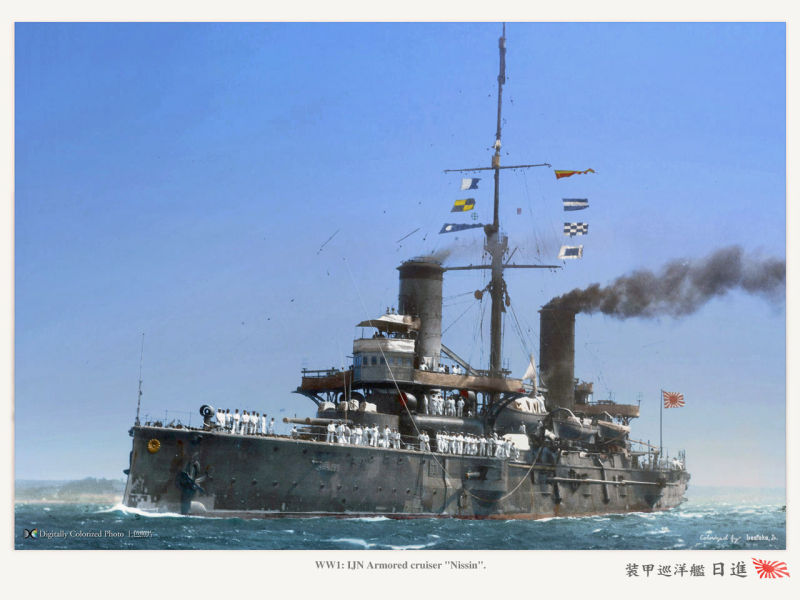
IJN Kasuga, the last of the export cruisers, with Nisshin both rocking at the battle of the Yellow Sea and Tsushima. Colorized by Irootoko Jr.
But the design itself was a new starting point to the Regia Marina to built even larger armoured cruiser classified as “battleships” but in reality large “armored cruisers” such as the Regina Margherita-class and Regina Elena-class battleships in 1904, also forerunners to monocaliber battleships seen through by Colonel Cuniberti.
The consequence of this strategic vision was saw the confirmation of armored cruisers at this level of development with upgraded, larger units not only able to compete with battleships but also potentially out-do them by superior speed and agility. Italy with this class was one of the progenitor of the concepts of both, the fast monocaliber battleship (Dreadnought), and the battlecruiser in a sense.
First published on Nov 13, 2017
Career
Note: I will not cover here the whereabouts of the export cruisers: They will be seen in their own respective posts for the sake of clarity, and to appear in their respective Spanish, Argentinian, and Japanese lists. Here is the career of all three Italian cruisers only, spanning from 1902 to 1915, 1922 and 1931 depending on their fate. All three saw in addition to WWI the Italo-Turkish War but not the Balkan war. They were part of the same unit most of the time, but never had the occasion to fight other ships, mostly putting their heavy guns to good use in coastal bombardments instead, and even capturing towns and sending landing parties.
 Francesco Ferruccio (1902)
Francesco Ferruccio (1902)
Francesco Ferruccio (after the condottiere), was built in Venice, launched 23 April 1902 and baptised by the Duchess of Genoa, completed on 1 September 1905. She took part in this year’s fleet maneuvers as part of the “hostile” force blockading La Maddalena in Sardinia. Joined in the same unit with her sisters Giuseppe Garibaldi and Varese, she made her first visit to a foreign port, Marseilles, France, on 15–16 September 1906, a remarked part of the fleet review held for French Pdt. Armand Fallières. Later Francesco Ferruccio made a cruise to the Levant (Syria-Lebanon), in July 1909. She was deployed to Crete from 26 June 1910 to January 1911. Her home port was Taranto in 1911.
Italo-Turkish War
On 29 September 1911, Francesco Ferruccio was assigned to the 4th Division, 2nd Squadron with her sisters Garibaldi and Varese. The first two shelled Tripoli on 3–4 October for their first mission, Varese being in watch for the incoming Ottoman fleet. On 13 October, the cruisers recoaled at Augusta, Sicily and both Ferruccio and Garibaldi were again detached to bombard Beirut (24 February 1912) while Varese stood in watch. Doing so, they sank in harbor the old ironclad Avnillâh, used a guardship, and forced the torpedo boat Ankara to scuttle, not to be captured. Varese in some sources also participated at some point. Ferruccio was then transferred to Libya, remaining there until the war ended.
The First Balkan War, showed her deployed to Albania (18 February-5 June 1913) and again on 4 January-7 February 1914.

Mytilene Island, Aegean sea, Italian cruisers
WWI service
In May 1915 Italy was at war agains the central powers, and Ferruccio was assigned to the 5th Cruiser Division in Brindisi. On 5 June, she took part of a bombardment of railways near Ragusa. She left Brindisi on 17 July for another shelling sortie off Ragusa Vecchia. However at 04:00, Giuseppe Garibaldi was torpedoed by the Austro-Hungarian submarine U-4 and sank in a short span, just minutes, carrying with her 53 crewmen.
This forced the division to wihdraw immediately and further attacks were cancelled. They left three destroyers to rescue survivors. This crippling loss, added to the one of armored cruiser Amalfi (Pisa class) by another submarine on 7 July put a hard stop to any activities in the Adriatic Sea as decided by admiral Paolo Thaon di Revel. Francesco Ferruccio was stationed to the Levant (19 November-22 December) and send to Brindisi for a short refit. Afterwards she proceeded to several escort missions, protecting convoys to Albania. She also patrolled the Albanian coast until the fall of 1918.
After the war due to her already old design, Francesco Ferruccio was no longer attached to an active unit, but kept as a cadet training ship in 1919. Found good enough for the role, she was fully converted with new accomodations and a larger panel of armaments, back in service by 1924. On 30 July 1922, she collided with the Spanish cargo Ayala Mendi, in the Bay of Biscay. The latter sank withing minuts, and the cruiser, which only had superficial damage proving the soundness of her construction, rescued all but 33 of her crew. The rest of her years were quite peaceful and uneventful, shared between times in home waters and training cruisers. She also escaped due to her status the axe blows resulting of the Washington treaty. A new generation of light and heavy cruisers were now filling the ranks of the Regia Marina; She was eventaully decommissioned and stricken on 1 April 1930, sold for BU afterwards.
 Giuseppe Garibaldi (1899)
Giuseppe Garibaldi (1899)
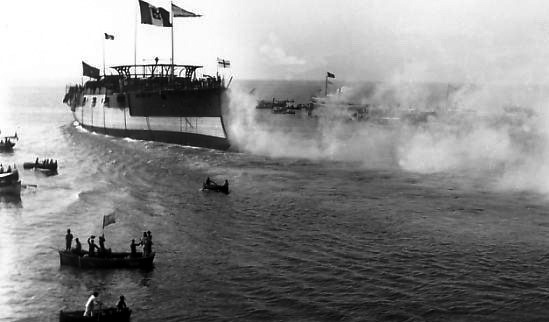
Launch of Garibaldi at Ansaldo in 1899
Giuseppe Garibaldi (after Italian General, statesman and Country Founding father General Giuseppe Garibaldi) was built at Gio. Ansaldo & C. shipyard in Genoa-Sestri Ponente. Launched on 29 June 1899 she experienced an incident prior to commission, during her steam trials, on 12 July 1900: Two boiler’s tubes burst, killing one, gravely burning two other sailors. Inspecting and replacing all tubes went on until 10 August, so she completed her sea trials on 1 January 1901 and commissioned soon after.
From 23 July to 2 October 1902, she made a long training cruise in the Mediterranean, stopping in Tripoli and the Aegean Sea. In 1903 she did the same, this time stopping at Algiers, Salonica, and Piraeus in Greece. With her sisters at the 1905 fleet maneuvers, she was assigned to the “hostile” force off Sardinia. She was later detached to join the international expeditionary force occupying Lemnos and Mytilene, in November–December 1905. This was in a failed effort to force the Ottoman Empire to pay its debts to European Banks. Back with her sisters Ferruccio and Varese, she took part in the naval review in Marseilles (15–16 September 1906) and like Ferruccio she was was deployed to the Levant (May–July 1907) but also again in June 1908.
Italo-Turkish War
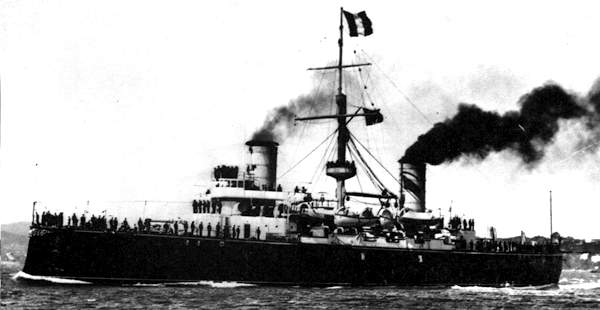
From 29 September 1911 she became flagship of the 4th Division, 2nd Squadron with her sisters. The 2nd Sqn was under orders of Rear Admiral Paolo Thaon di Revel. She took part in the same bombardment missions as her sister Ferruccio, starting with Tripoli on 3–4 October. In fact, Giuseppe Garibaldi was the first to enter the harbor, sending a landing party which made its way into Fort Hamidiye, disabled the fort’s guns beech and raising the flag. The shelling left 12 Ottoman soldiers dead, wounding 23 and 7 civilians. On 13 October after a stop to recoal in Augusta, Sicily they sailed to Tobruk in January 1912.
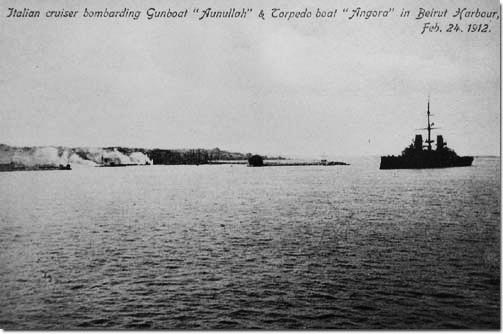
Battle of Beirut
Next, they bombarded Beirut, on 24 February 1912 (claiming Avnillâh). In fact, after having her set alight, Giuseppe Garibaldi entered the harbor and torpedoed the ironclad to good measure. Her secondary fire disabled the torpedo boat Ankara, which also scuttled herself. The shelling made 140 civilian victims, wounding more than 200. On 18 April, Garibaldi and Varese were sent for a nother bombardment mission, this time on the Dardanelles forts. The first took heavy damage, which conducted the Ottoman high command to ask Germany to improve them. We know how this turned out in 1915… Back in Italy by late April she started a refit until mid-June. Her worn-out guns were replaced. Her two sisters followed suit.
She did not participated in the First Balkan War in May 1913 but was deployed after it in the Albanian port of Scutari to watch over its passation by Montenegro to the Ottoman Empire. She also stand guard to protect Italian interests there, and went back home in August. Next year in February-March 1914, she was stationed in Benghazi.
WWI and Sinking

From May 1915, Garibaldi stayed as flagship of the 5th Cruiser Division (Rear Admiral Eugenio Trifari) based in Brindisi. On 5 June, the division sorties in the Adriatic. The first mission was to bombard, with her sisters, the rail lines near Ragusa (Dubrovnik). The next day, she did the same off Ragusa Vecchia, but soon after the start of the bombardment at 04:00, Giuseppe Garibaldi was struck without warning by a single torpedo from Austro-Hungarian U4.
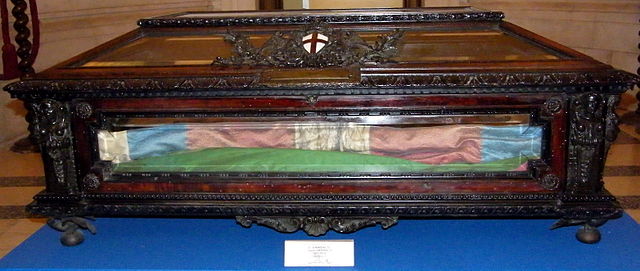
Main flag of Garibaldi saved from the sinking
The torpedo hit her starboard side, near the aft boiler rooms. The blast presumably went through the first layer of compartimentation and breeched the engine rooms. The flooding was soon uncontrollable and she sank very quickly, in minutes, but on an even keel, nor rolling over, which saved most of her crew, raking with her 53 crewmen, most being trapped inside the lower levels and machinery rooms.
The remaining 525 could survive in these mildly cold waters, and were rescued by three destroyers, left behind while Ferruccio steamed out of the area by order, joining Varese. Just after rescuing survivors, the destroyers derparted at full speed and joined the the division, which retreated to Italy. This event (plus the loss of Amalfi) constrained Di revel to avoid any further exposure of major Italian ships in the Adriatic. Only fast, scout cruisers, destroyers and TBs would be deployed and the “Otranto Barrage” was setup until the end of the war.
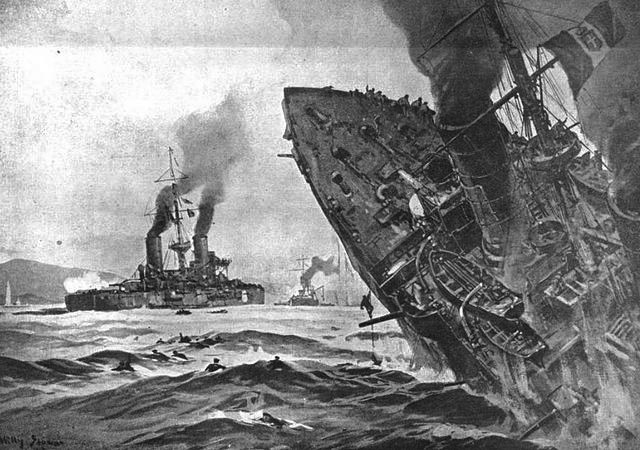
The wreck of the Giuseppe Garibaldi did not stayed oin an event keel but apparently rolled over as she was rediscovered upside-down at 42°28.362′N 18°16.758′ and 42°28.362′N 18°16.758′E, south-east of Dubrovnik, now in Croatia below 122 meters (400 ft). At forst she was uncovered by a Czech expedition in 2008, but she claimed a diver on 9 September. Without permits to explore what os now a war grave, another Croatian expedition explored and filmed her in August 2009 using CCR technology. Others followed in November 2009 and May 2010 with underwater archaeologists, making her one of the best known modern wreck in the Adriatic.
 Varese (1899)
Varese (1899)
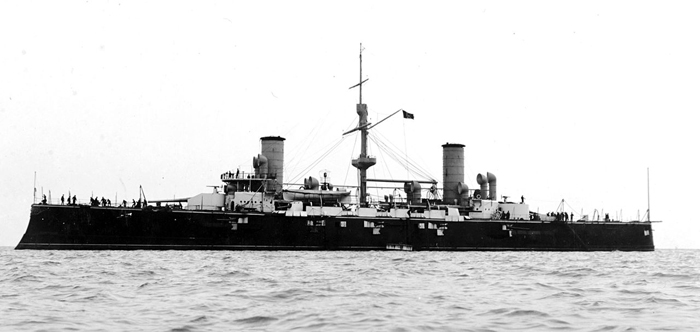
Varese prewar
Varese (in reference to the Battle of Varese, Second Italian War of Independence) was built at Orlando, Livorno, launched on 6 August 1899, completed on 5 April 1901 and making her sea trials without incident. After working out and initial training she departed for her first long cruise, visiting Algiers on 14 September 1903, Barcelona on 4 April 1904. She took part in the 1905 fleet maneuvers in the “hostile” force off Sardinia.
Varese was the only of the sisters present off Athens during the Olympic Games of April 1906, representing the country. Back with Ferruccio and Garibaldi she visited Marseilles on 15–16 September 1906 for the presidential fleet review. By May 1907 she departed for the US, showing the flag at the Jamestown Exposition with honored guest and command of Prince Luigi Amedeo, Duke of the Abruzzi. Nothing of note for 1908. Like her sisters she was assigned in October 1909 to the levant, and returned home on 20 February 1910 via Suda Bay in Crete where she stayed from 23 August to 20 September 1911.
Italo-Turkish War
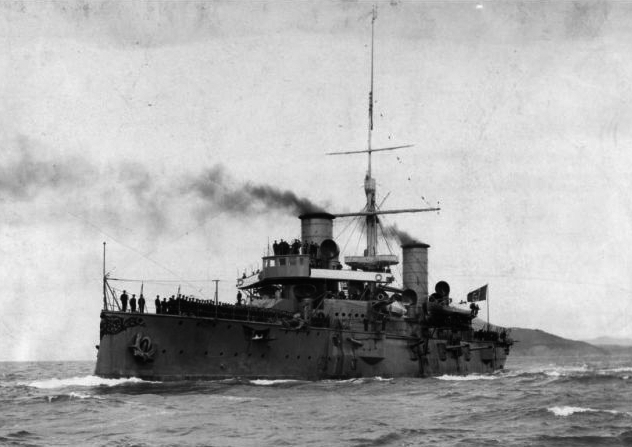
From 29 September 1911, like her sisters she was in the 4th Division, 2nd Squadron ands took part in the bombardment of Tripoli on 3–4 October but not activaly as she was deployed away at sea to stand watch for any incoming Ottoman ships, what is usually called a “distant cover”, but also probably to a certain frustration from the crew. On 13 October, the three recoaled at Augusta. While both reutned to another bombardment, Varese was dectahed to escorted two troop transports and a hospital ship. On 16 October, she escorted yet another troop convoy to Homs, and this time bombarded the Ottoman town. This happened after she signalled the fort to surrender, which Commander refused. Bad weather however prevented her to send a landing party, which only was launched on 21 October. She covered the progression of the Marines backed by armed sailors to the Fort, and its capture. She also provided fire support in support for the troops.
Varese and Garibaldi were in Tobruk in January 1912, standing guard for any sortie of the Ottomans, while the rest of the fleet was refitting in Italy. Varese may or may not have taken part of the bombardment of Beirut, on 24 February 1912. She was prehaps detached at some point to join in, but was normally assigned as distant cover. On 18 April Varese and Garibaldi shelled the fortifications of the Dardanelles (southermost forts), blasting them outright. She was back in Italy by late April and like Garibaldi, her her worn out guns replaced. She was operational again in mid-June.
Varese in WWI
She was poissibly sent in benghazi in early to mid-1914, but stationed in Brindisi with the 5th Cruiser Division in May 1915. On 5 June she sortied with her sisters to shell and completely destroy the Austro-Hungarian rail line hub at Ragusa to disrupt troop reinforcements to the north. On 17 July she joined her sisters for another such missions off Ragusa Vecchia when at 04:00, Giuseppe Garibaldi was torpedoed and sank. U4 launched a full four array, one torpedo spotted passing between Varese and Garibaldi. This could have been far more deadly, close to what happened on 22 September 1914 with Aboukir, Cressy, and Hogue with Weddingen’s U 9. That was a second wakeup call to the brand new submarine preile, and not the last. All 1890s designs were at risk.
Varese and the division left immediately, leaving escorting destroyers behind at the rescue. After the loss of Amalfi on 7 July it was clear that sorties from Venice and activities in the Adroatic at large would be severely restricted from now on. The setup of the Otranto Barrage saw many ships “taking turns of duty” Italian but also British and French, to patrol the strait closing the Adriatic. Only a few sorties were spotted, generally to attack Italian mineslayers, and in one of these, on 15 May 1917, as full Austro-Hungarian Fleet attacked when it was turn of Varese to stand guard from the port of Butrino, north coast of Corfu. She however was too slow to make a sortie when signalled. The fast ships were already away after skirmishing.
The rest of the war, in 1917-18 was uneventful. After the war she retained her post in 1919, but was reclassified as training ship for cadets in 1920 and until 1922. Unlike Ferruccio she was not transformed as TS but rather decomissioned and stricken on 4 January 1923, sold for BU afterwards.
Links/Sources
Books
Beehler, William Henry (1913). The History of the Italian-Turkish War. USNI
Curtis, W. D. (1907). The Log of H.M.S. Cumberland, 2nd Cruiser Squadron, 1904–1906.
Fraccaroli, Aldo (1970). Italian Warships of World War I. London: Ian Allan.
Freivogel, Zvonimir (2012). Jordan, John (ed.). The Loss of the Giuseppe Garibaldi. Warship 2012.
Gardiner, Robert & Gray, Randal, eds. (1985). Conway’s All the World’s Fighting Ships: 1906–1921.
Langensiepen, Bernd; Güleryüz, Ahmet (1995). The Ottoman Steam Navy 1828–1923.
Marchese, Giuseppe (June 1995). “La Posta Militare della Marina Italiana puntata”. La Posta Militare
“Professional Notes–Italy”. Proceedings of the United States Naval Institute. NIP
Silverstone, Paul H. (1984). Directory of the World’s Capital Ships. New York: Hippocrene Books
Soliani, Colonel N. (1905). “The Armoured Cruisers Kasuga and Nisshin of the Imperial Japanese Navy”. Henry Sotheran & Co. XLVII
Sondhaus, Lawrence (2001). Naval Warfare, 1815–1914. London: Routledge.
Stephenson, Charles (2014). A Box of Sand: The Italo-Ottoman War 1911–1912: The First Land, Sea and Air War.
United States Office of Naval Intelligence, United States Navy (July 1901). “Steam Trials–Italy”. Government Printing Office
John Gardiner’s Conways all the world’s fighting ships 1860-1906, Italian section
Links
https://www.marina.difesa.it/noi-siamo-la-marina/mezzi/mezzi-storici/Pagine/EFGHI/garibaldi_corazzato.aspx
https://www.navypedia.org/ships/italy/it_cr_giuseppe_garibaldi.htm
http://www.histarmar.com.ar/Armada%20Argentina/10Cruceros-1Caract.htm
http://www.histarmar.com.ar/InfHistorica/AntiguaFlotadeMar/ClaseGaribaldi.htm
https://it.wikipedia.org/wiki/Giuseppe_Garibaldi_(incrociatore_1899)
https://it.wikipedia.org/wiki/Classe_Giuseppe_Garibaldi
http://www.navweaps.com/Weapons/WNJAP_10-40_EOC.php
http://www.histarmar.com.ar/Armada%20Argentina/10cruceros/10Cruceros-14GiuseppeGaribaldi.htm
https://web.archive.org/web/20071004213631/http://www.sullacrestadellonda.it/navi_marina/incrociatoregaribaldi.htm
http://www.pietrocristini.com/schede_tecniche_navi_italiane.htm
Garibaldi class on wikipedia
on navypedia.org
https://commons.wikimedia.org/wiki/Category:Giuseppe_Garibaldi_class_cruiser

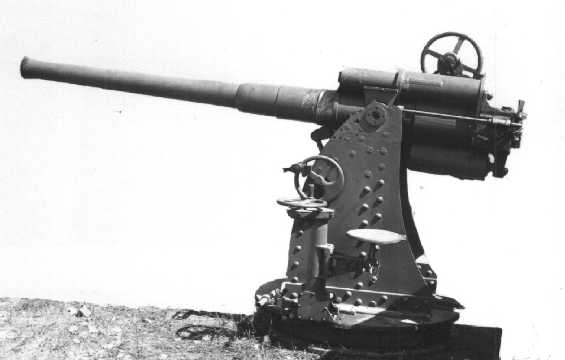
 Latest Facebook Entry -
Latest Facebook Entry -  X(Tweeter) Naval Encyclopedia's deck archive
X(Tweeter) Naval Encyclopedia's deck archive Instagram (@navalencyc)
Instagram (@navalencyc)





 French Navy
French Navy Royal Navy
Royal Navy Russian Navy
Russian Navy Armada Espanola
Armada Espanola Austrian Navy
Austrian Navy K.u.K. Kriegsmarine
K.u.K. Kriegsmarine Dansk Marine
Dansk Marine Nautiko Hellenon
Nautiko Hellenon Koninklije Marine 1870
Koninklije Marine 1870 Marinha do Brasil
Marinha do Brasil Osmanlı Donanması
Osmanlı Donanması Marina Do Peru
Marina Do Peru Marinha do Portugal
Marinha do Portugal Regia Marina 1870
Regia Marina 1870 Nihhon Kaigun 1870
Nihhon Kaigun 1870 Preußische Marine 1870
Preußische Marine 1870 Russkiy Flot 1870
Russkiy Flot 1870 Svenska marinen
Svenska marinen Søværnet
Søværnet Union Navy
Union Navy Confederate Navy
Confederate Navy Armada de Argentina
Armada de Argentina Imperial Chinese Navy
Imperial Chinese Navy Marinha do Portugal
Marinha do Portugal Mexico
Mexico Kaiserliche Marine
Kaiserliche Marine 1898 US Navy
1898 US Navy Sovietskiy Flot
Sovietskiy Flot Royal Canadian Navy
Royal Canadian Navy Royal Australian Navy
Royal Australian Navy RNZN Fleet
RNZN Fleet Chinese Navy 1937
Chinese Navy 1937 Kriegsmarine
Kriegsmarine Chilean Navy
Chilean Navy Danish Navy
Danish Navy Finnish Navy
Finnish Navy Hellenic Navy
Hellenic Navy Polish Navy
Polish Navy Romanian Navy
Romanian Navy Turkish Navy
Turkish Navy Royal Yugoslav Navy
Royal Yugoslav Navy Royal Thai Navy
Royal Thai Navy Minor Navies
Minor Navies Albania
Albania Austria
Austria Belgium
Belgium Columbia
Columbia Costa Rica
Costa Rica Cuba
Cuba Czechoslovakia
Czechoslovakia Dominican Republic
Dominican Republic Haiti
Haiti Hungary
Hungary Honduras
Honduras Estonia
Estonia Iceland
Iceland Eire
Eire Equador
Equador Iran
Iran Iraq
Iraq Latvia
Latvia Liberia
Liberia Lithuania
Lithuania Mandchukuo
Mandchukuo Morocco
Morocco Nicaragua
Nicaragua Persia
Persia San Salvador
San Salvador Sarawak
Sarawak Uruguay
Uruguay Venezuela
Venezuela Zanzibar
Zanzibar Warsaw Pact Navies
Warsaw Pact Navies Bulgaria
Bulgaria Hungary
Hungary

 Bundesmarine
Bundesmarine Dutch Navy
Dutch Navy Hellenic Navy
Hellenic Navy Marina Militare
Marina Militare Yugoslav Navy
Yugoslav Navy Chinese Navy
Chinese Navy Indian Navy
Indian Navy Indonesian Navy
Indonesian Navy JMSDF
JMSDF North Korean Navy
North Korean Navy Pakistani Navy
Pakistani Navy Philippines Navy
Philippines Navy ROKN
ROKN Rep. of Singapore Navy
Rep. of Singapore Navy Taiwanese Navy
Taiwanese Navy IDF Navy
IDF Navy Saudi Navy
Saudi Navy Royal New Zealand Navy
Royal New Zealand Navy Egyptian Navy
Egyptian Navy South African Navy
South African Navy






























 Ukrainian Navy
Ukrainian Navy dbodesign
dbodesign